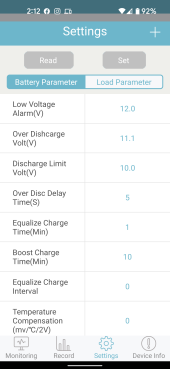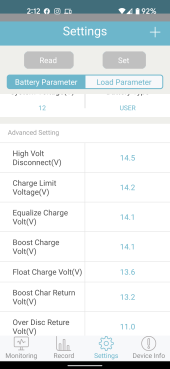Yes, the LI settings will tend to overcharge your battery. At 14.4v LiFePO4 are in a very high charge state. Above 14.6v there is risk of damage to the battery. If the Rover-40 truly stopped charging at 14.4v it may be OK, but I find the Rover-40 can be off my 0.1 or 0.2v and this is common with this solar charge controller. Also, at 14.4v you are at high risk of the BMS in your battery going into overvoltage shutdown which can cause problems.
Your BMS in your battery will (or should) shut down your battery before any damage to the cells with overvoltage or undervoltage protection, but you don't want to use this feature to run your solar system since it is a failsafe. You need to program the Rover-40 Boost Voltage to a voltage below your BMS overvoltage and you need to remove your loads before the battery BMS goes into undervoltage or make sure the battery voltage never gets that low (this can be done with an automatic transfer switch when using an inverter/grid power).
Min voltage for LiFePO4 Cells is usually 2.5v or 4x 2.5 = 10 Volts and Max voltage for LiFePO4 Cells is usually 3.65v or 4x 2.5 = 14.6 Volts
Your BMS may cut out before the Min or Max Voltage depending on how it is programmed, but you don't want to exceed the Min or Max and really keep a buffer above the min and below the max.
So, with the Rover-40 set to 14.4v and a voltage error of 0.2 you can get to 14.6 (or more) and damage your battery or your BMS will kick in to save your battery and shut things down.
The Rover-40 is not a precise SCC, but given its price point and the BT and ability to program and monitor on your phone it is a good value for entry/small solar systems. After some time (my 3rd year) I have learned to use it well. Just have to know its limitations...
I use the Renogy BT-1 Bluetooth Module that plugs in the Rover-40 Rs232 port.
www.amazon.com/Renogy-Bluetooth-Module-Communication-Controllers/dp/B0894SDTSL
With that Module I use the Renogy BT App loaded on my phone to program the settings and monitor the Rover-40 and is free.
APP for solar charge controller operation in smart PV power system. It's for solar charge controller working parameter setting and reading. All data can be displayed in a diagram. Meet the Renogy BT. a convenient way to manage and monitor your solar power system all in the palm of your hand...
apps.apple.com
a convenient way to manage and monitor your solar power system

play.google.com
I use the App and this is why the settings don't make much sense for programming in the Rover-40 itself.
I will try to translate what I see in the manual:
over-voltage Warning 14.5
Equalization Voltage 14.1
Boost Voltage 14.1
Float Voltage 13.6
Boost Return Voltage 13.4
Under Voltage Warning 10.9
Under Voltage Recover 11
Low Voltage Disconnect 10
Low Voltage Reconnect 11.2
Equalization Duration 0 Hrs.
Boost Duration 1 Hrs.
This will get you started and you can adjust for you battery as you gain experience with it.
I don't worry very much about the Low/ Under voltage settings since my Inverter/Charger with transfer switch should take care of that, but your circumstances maybe different.
Be sure to disconnect the Battery Temp Sensor. It is not needed for LiFePO4 batteries and will mess with the charging.
I strongly recommend the Renogy BT Module and the Renogy BT App. It allows more programming features and monitoring with a Google Android or Apple ios phone.
hope this helps...





